Effects of Growing Substrates on Plant Nutrient Yield and Yield Component of 4 Melon Cultivars (Cucumis melo L.) under the Soilless Cropping System
Keywords:
Melon, varieties, growing substrates, แตงเทศ, พันธุ์, วัสดุปลูกAbstract
The purpose of this experiment was to study the effect of growing substrates on growth and qualities of yield of four melon cultivars. The experimental setup was 5 x 4 Factorial in Randomized Complete Block Design with 4 replications. Factor 1 was 5 growing substrates including coir dust, sand+coir dust, sand+husk charcoal, sand+vermicompost and sand+filter cake ratio of 1:1 by volume and factor 2 was 4 commercial melon cultivars (Kimoji, Marriage, Emerald Sweet, and Galia). The result revealed that the macronutrient concentrations of nitrogen, phosphorus and potassium of melon leaf at 8 weeks were between 3.29-4.45, 0.41-0.65 and 2.62-5.94 %, respectively. Among all given substrate treatments, sand+filter cake gave the highest fruit weight. Observations on width and length of fruits showed that galia cultivars grown in sand+filter cake gave the largest fruit size. Kimoji had the highest peel thickness. Interactions were found between cultivars and growing substrates on pulp thickness. Growing Marriage cultivar in sand+vermicompost gave the highest peel thickness. Kimoji grown in sand+filter cake and sand+vermicompost produced high amounts of total soluble solid. The study of growth yield and yield qualities showed that the sand+filter cake gave the best yield and yield qualities. Correlation tests indicated that yield and yield qualities of melon depended on contents of macronutrients in melon leaf. Therefore, the use of growing substrates was sand + filter cake helps to increase the yield of all 4 varieties of melon and recommend farmers and people interested in melon production.
การศึกษาวัสดุปลูกชนิดต่างๆ ที่ส่งผลต่อการเจริญเติบโต และคุณภาพของผลผลิตแตงเทศพันธุ์ต่างๆ โดยวางแผนการทดลองแบบ 5 x 4 แฟคทอเรียลแบบสุ่มสมบูรณ์ภายในบล็อค จำนวน 4 ซ้ำ และจัดสิ่งทดลองแบบ 2 ปัจจัย คือปัจจัยที่ 1 วัสดุปลูก 5 ชนิด (ขุยมะพร้าว ทรายผสมขุยมะพร้าว ทรายผสมแกลบเผา ทรายผสมมูลไส้เดือนดิน และทรายผสมกากตะกอนอ้อย) โดยใช้อัตราส่วน 1:1 โดยปริมาตร ปัจจัยที่ 2 แตงเทศ 4 พันธุ์ (พันธุ์คิโมจิ พันธุ์แมริเอจ พันธุ์เอ็มมิรัล สวีท และพันธุ์กาเลีย) ผลการศึกษาพบว่า ความเข้มข้นของธาตุอาหารหลักในใบแตงเทศที่ระยะ 8 สัปดาห์มีไนโตรเจน ฟอสฟอรัส และโพแทสเซียม 3.29–4.45 % 0.41-0.65 % และ2.62-5.94 % ตามลำดับ แตงเทศที่ปลูกในทรายผสมกากตะกอนอ้อยให้น้ำหนักเฉลี่ยของผลสูงที่สุด พันธุ์กาเลียที่ปลูกในทรายผสมกากตะกอนอ้อยให้ขนาดของผลใหญ่ที่สุด ส่วนพันธุ์คิโมจิให้ความหนาเปลือกสูงที่สุด ความหนาเนื้อของแตงเทศมีปฏิสัมพันธ์กันระหว่างพันธุ์และวัสดุปลูก โดยทรายผสมมูลไส้เดือนให้ความหนาเนื้อแตงเทศพันธุ์แมริเอจดีที่สุด พันธุ์คิโมจิและกาเลียให้ปริมาณของแข็งที่ละลายน้ำได้เฉลี่ยสูงที่สุด แตงเทศพันธุ์คิโมจิที่ปลูกในทรายผสมขุยมะพร้าว และทรายผสมมูลไส้เดือน ให้ปริมาณของแข็งที่ละลายน้ำได้สูง ทรายผสมกากตะกอนอ้อยให้ความสมบูรณ์ของผลผลิต และองค์ประกอบผลผลิตดีที่สุดเมื่อเทียบกับขุยมะพร้าวเพียงอย่างเดียว จากค่าสหสัมพันธ์ระหว่างธาตุอาหารพืชและองค์ประกอบผลผลิตแตงเทศ พบว่า ปริมาณธาตุอาหารหลักในใบพืช ส่งผลต่อผลผลิตและองค์ประกอบของแตงเทศ ดังนั้นการใช้วัสดุปลูกทรายผสมกากตะกอนอ้อย ช่วยเพิ่มผลผลิตของแตงเทศทั้ง 4 พันธุ์ และสามารถแนะนำเกษตรกรและผู้สนใจในการผลิตแตงเทศ
Downloads
Published
How to Cite
Issue
Section
License

This work is licensed under a Creative Commons Attribution-NonCommercial-NoDerivatives 4.0 International License.



